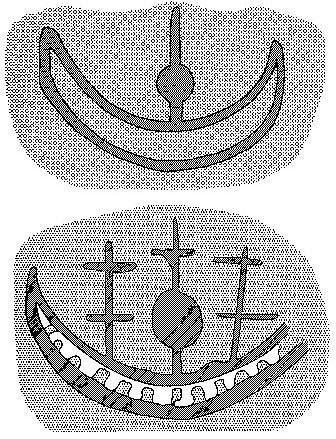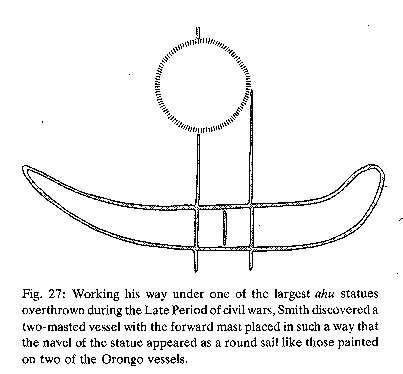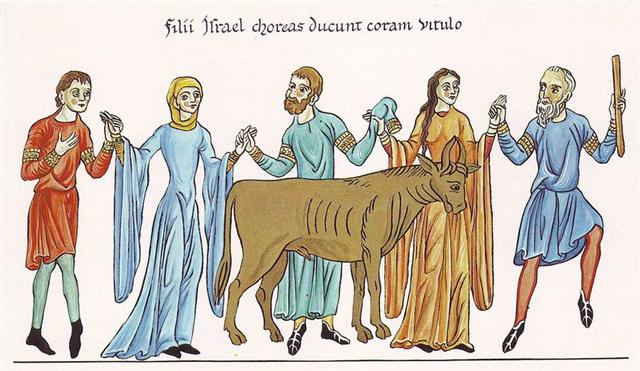3. For the children it could be explained that the Sun was moving across the blue sky because he went in a canoe, the shape of which agreed with that of the Moon crescent as viewed from a point close to the equator:
... the equinoctial 'points' - and therefore, the solstitial ones, too - do not remain forever where they should in order to make celestial goings-on easier to understand, namely, at the same spot with respect to the sphere of the fixed stars. Instead, they stubbornly move along the ecliptic in the opposite direction to the yearly course of the sun, that is, against the 'right' sequence of the zodiacal signs (Taurus→Aries→Pisces, instead of Pisces→Aries→Taurus). This phenomenon is called the Precession of the Equinoxes, and it was conceived as causing the rise and the cataclysmic fall of ages of the world. Its cause is a bad habit of the axis of our globe, which turns around in the manner of a spinning top, its tip being in the center of our small earth-ball, whence our earth axis, prolonged to the celestial North Pole, describes a circle around the North Pole of the ecliptic, the true 'center' of the planetary system, the radius of this circle being of the same magnitude as the obliquity of the ecliptic with respect to the equator: 23 ½º. The time which this prolonged axis needs to circumscribe the ecliptical North Pole is roughly 26,000 years, during which period it points to one star after another: around 3000 B.C. the Pole star was alpha Draconis; at the time of the Greeks it was beta Ursae Minoris; for the time being it is alpha Ursae Minoris; in A.D. 14,000 it will be Vega. The equinoxes, the points of intersection of ecliptic and equator, swinging from the spinning axis of the earth, move with the same speed of 26,000 years along the ecliptic. The sun's position among the constellations at the vernal equinox was the pointer that indicated the 'hours' of the precessional cycle - very long hours indeed, the equinoctial sun occupying each zodiacal constellation for about 2,200 years. The constellation that rose in the east just before the sun (that is, rose heliacally) marked the 'place' where the sun rested. At this time it was known as the sun's 'carrier', and as the main 'pillar' of the sky, the vernal equinoxes being recognized as the fiducial point of the 'system', determining the first degree of the sun's yearly circle, and the first day of the year. (When we say, it was 'recognized', we mean that it was spelled 'carrier' or 'pillar', and the like: it must be kept in mind that we are dealing with a specific terminology, and not with vague and primitively rude 'beliefs'.) At Time Zero (say, 5000 B.C. - there are reasons for this approximate date), the sun was in Gemini; it moved ever so slowly from Gemini into Taurus, then Aries, then Pisces, which it still occupies and will for some centuries more. The advent of Christ the Fish marks our age. It was hailed by Virgil, shortly before Anno Domini: 'a new great order of centuries is now being born...' which earned Virgil the strange title of prophet of Christianity. The preceding age, that of Aries, had been heralded by Moses coming down from Mount Sinai as 'two-horned', that is, crowned with the Ram's horns, while his flock disobediently insisted upon dancing around the 'Golden Calf' that was, rather, a 'Golden Bull', Taurus ...
The age of the Bull - the time when Aldebaran rose heliacally at spring equinox (as observed from a point north of the equator) - was used by the creator of the G tablet for the beginning of his text on side a of the tablet, its front (face) side:
The rongorongo texts are running from left to right, but our star maps have right ascension time running from right to left (like the texts of the Arabs). Aldebaran is α Tauri and Ain (Eye) is ε. At the end of side b of the tablet we can find the origin of the bifurcation at γ Tauri (Hyadum I):
The position of the 3 stars δ Tauri (Hyadum II) was corresponding to the Gregorian equinox (0h) whereas Aldebaran was at the Julian equinox (day 84).
|










